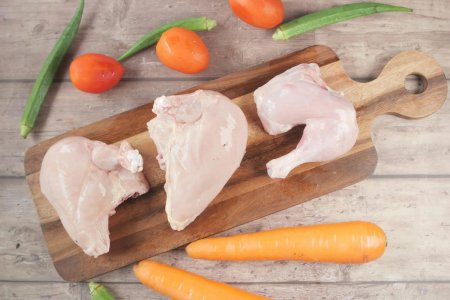Is your chicken safe? USDA decision could affect your health
By
Veronica E.
- Replies 0
When it comes to the food we put on our plates, safety is just as important as taste—especially for older adults who may have more sensitive immune systems.
Ensuring that what we eat is not only delicious but also safe is a responsibility we take seriously, whether we’re preparing a meal for ourselves or for our loved ones.
For many of us, peace of mind about the meals we serve to our families is something we hold dear, knowing that good food should nourish and protect, not cause worry.
That’s why a recent decision from the United States Department of Agriculture (USDA) is catching attention and stirring concern across the country.
With food safety always a top priority, changes in regulation can have real impacts on the choices we make at the grocery store and in our kitchens.

The USDA recently announced the withdrawal of a proposed rule, originally introduced during the Biden administration, that aimed to limit salmonella levels in raw poultry.
This proposal, which had been in development for three years, would have set thresholds for allowable salmonella levels and required testing for six strains most commonly linked to foodborne illnesses.
Poultry that exceeded the limits or tested positive for certain strains would have been prevented from reaching grocery store shelves and subject to recall.
The plan was seen by many food safety advocates as a proactive step toward reducing the risk of salmonella-related illnesses.
According to the USDA, chicken alone accounts for an estimated 125,000 salmonella infections each year, while turkey is responsible for about 43,000.
The Centers for Disease Control and Prevention (CDC) reports that salmonella causes roughly 1.35 million infections annually across the United States, leading to around 420 deaths.
The consequences of foodborne illness can be serious.
Federal researchers identified salmonella as one of six major pathogens contributing to nearly 10 million foodborne illness cases in the United States each year, resulting in hundreds of deaths and billions of dollars in healthcare costs.
Despite these findings, the USDA’s Food Safety and Inspection Service decided to withdraw the proposed rule, citing the need to "further assess its approach for addressing Salmonella illnesses associated with poultry products" after receiving over 7,000 public comments.
Officials stated they would re-evaluate whether updates to current salmonella regulations are necessary.
The decision to pull back the proposal has received mixed reviews.
The National Chicken Council, an industry trade group, praised the move, arguing that the original proposal misinterpreted scientific data, was legally questionable, and would have resulted in higher costs and more food waste without significantly improving public health.
"We remain committed to further reducing salmonella and fully support food safety regulations and policies that are based on sound science," said Ashley Peterson, the council’s senior vice president of science and regulatory affairs.
Source: Instagram / washingtonianprobs.
https://www.instagram.com/washingtonianprobs/
On the other side, several food safety advocates voiced disappointment.
Sandra Eskin, a former USDA official who helped craft the original proposal, criticized the decision, stating that it sends a troubling signal about public health priorities.
Sarah Sorscher of the Center for Science in the Public Interest compared the situation to the landmark 1994 move that banned certain dangerous strains of E. coli in ground beef after deadly outbreaks.
"Make no mistake: Shipping more salmonella to restaurants and grocery stores is certain to make Americans sicker," Sorscher said.
While larger policy discussions continue, it’s a good reminder for all of us to stay vigilant in our kitchens. Safe food handling practices can greatly reduce the risk of illness at home.
For members of The GrayVine community, staying informed and practicing safe food habits is an important part of protecting your health.
It’s also a good idea to stay engaged with food safety developments and voice concerns when necessary—after all, the policies set by regulatory agencies have a direct impact on our lives.
Read next: Eggs for dogs: Is your dog’s breakfast actually safe?

What are your thoughts on the USDA's decision to withdraw the salmonella rule? Do you have any tips for ensuring the poultry you eat is safe? Share your insights and join the conversation in the comments below.
Ensuring that what we eat is not only delicious but also safe is a responsibility we take seriously, whether we’re preparing a meal for ourselves or for our loved ones.
For many of us, peace of mind about the meals we serve to our families is something we hold dear, knowing that good food should nourish and protect, not cause worry.
That’s why a recent decision from the United States Department of Agriculture (USDA) is catching attention and stirring concern across the country.
With food safety always a top priority, changes in regulation can have real impacts on the choices we make at the grocery store and in our kitchens.

Practicing proper food safety at home remains important as regulatory policies continue to evolve. Image Source: Pexels / Towfiqu barbhuiya.
The withdrawn salmonella rule: What changed?
The USDA recently announced the withdrawal of a proposed rule, originally introduced during the Biden administration, that aimed to limit salmonella levels in raw poultry.
This proposal, which had been in development for three years, would have set thresholds for allowable salmonella levels and required testing for six strains most commonly linked to foodborne illnesses.
Poultry that exceeded the limits or tested positive for certain strains would have been prevented from reaching grocery store shelves and subject to recall.
The plan was seen by many food safety advocates as a proactive step toward reducing the risk of salmonella-related illnesses.
According to the USDA, chicken alone accounts for an estimated 125,000 salmonella infections each year, while turkey is responsible for about 43,000.
The Centers for Disease Control and Prevention (CDC) reports that salmonella causes roughly 1.35 million infections annually across the United States, leading to around 420 deaths.
Also read: Are your groceries putting you at risk? Nearly thousands die annually from this silent killer!
The impact of foodborne illnesses
The consequences of foodborne illness can be serious.
Federal researchers identified salmonella as one of six major pathogens contributing to nearly 10 million foodborne illness cases in the United States each year, resulting in hundreds of deaths and billions of dollars in healthcare costs.
Despite these findings, the USDA’s Food Safety and Inspection Service decided to withdraw the proposed rule, citing the need to "further assess its approach for addressing Salmonella illnesses associated with poultry products" after receiving over 7,000 public comments.
Officials stated they would re-evaluate whether updates to current salmonella regulations are necessary.
Also read: Warning: Over 30 products recalled for salmonella risk—is your food safe?
Mixed reactions: Industry and advocates respond
The decision to pull back the proposal has received mixed reviews.
The National Chicken Council, an industry trade group, praised the move, arguing that the original proposal misinterpreted scientific data, was legally questionable, and would have resulted in higher costs and more food waste without significantly improving public health.
"We remain committed to further reducing salmonella and fully support food safety regulations and policies that are based on sound science," said Ashley Peterson, the council’s senior vice president of science and regulatory affairs.
Source: Instagram / washingtonianprobs.
https://www.instagram.com/washingtonianprobs/
On the other side, several food safety advocates voiced disappointment.
Sandra Eskin, a former USDA official who helped craft the original proposal, criticized the decision, stating that it sends a troubling signal about public health priorities.
Sarah Sorscher of the Center for Science in the Public Interest compared the situation to the landmark 1994 move that banned certain dangerous strains of E. coli in ground beef after deadly outbreaks.
"Make no mistake: Shipping more salmonella to restaurants and grocery stores is certain to make Americans sicker," Sorscher said.
Also read: Don’t let salmonella ruin your meals! Must-know kitchen tricks to keep your family safe
What you can do: Protecting yourself at home
While larger policy discussions continue, it’s a good reminder for all of us to stay vigilant in our kitchens. Safe food handling practices can greatly reduce the risk of illness at home.
- Always wash hands thoroughly before and after handling raw meat.
- Use separate cutting boards for raw poultry and ready-to-eat foods.
- Cook chicken to an internal temperature of 165°F to kill harmful bacteria.
For members of The GrayVine community, staying informed and practicing safe food habits is an important part of protecting your health.
It’s also a good idea to stay engaged with food safety developments and voice concerns when necessary—after all, the policies set by regulatory agencies have a direct impact on our lives.
Read next: Eggs for dogs: Is your dog’s breakfast actually safe?
Key Takeaways
- The USDA has withdrawn a proposed rule aimed at limiting salmonella levels in raw poultry, citing the need for further assessment.
- The proposal would have set thresholds for salmonella levels and required testing for strains most associated with foodborne illness.
- The decision to withdraw the rule has been praised by the National Chicken Council and criticized by food safety advocates concerned about health risks.
- Food safety officials plan to re-evaluate current salmonella regulations following over 7,000 public comments on the proposal.
What are your thoughts on the USDA's decision to withdraw the salmonella rule? Do you have any tips for ensuring the poultry you eat is safe? Share your insights and join the conversation in the comments below.






